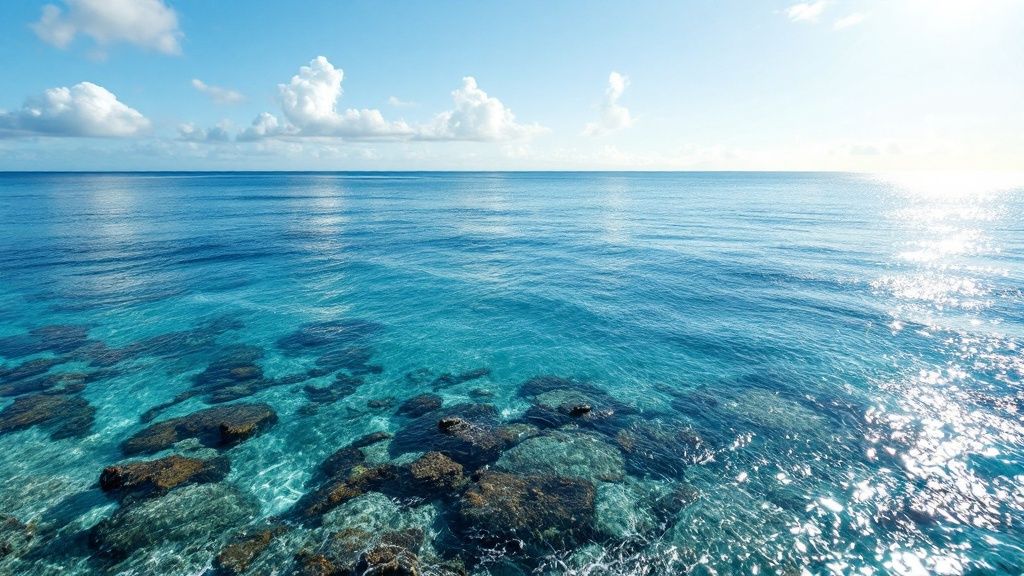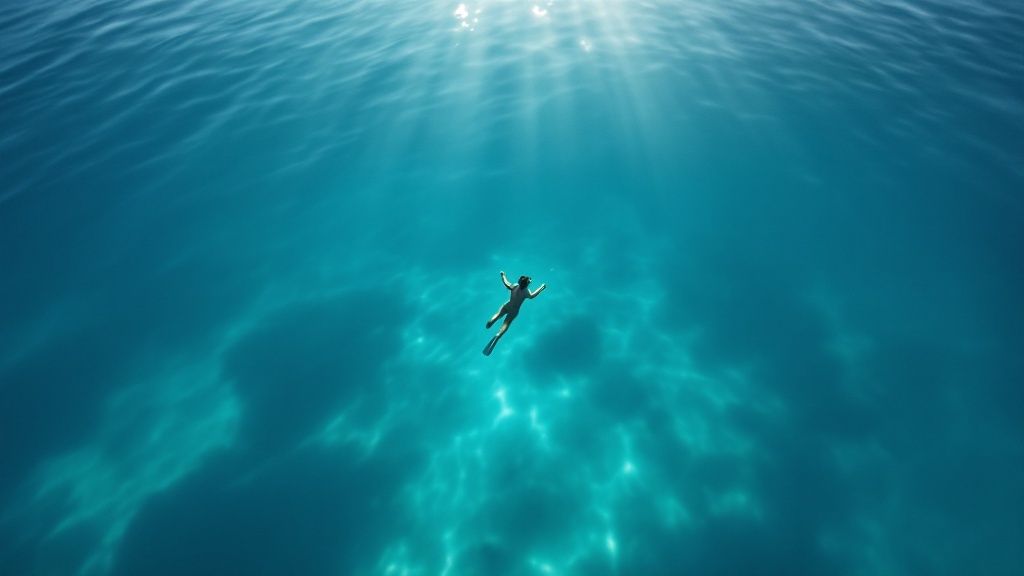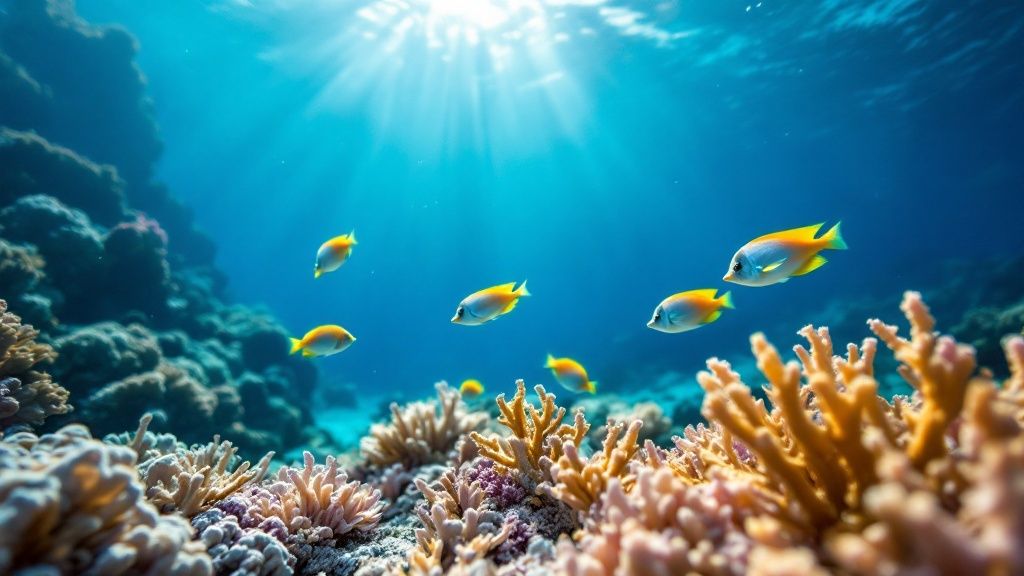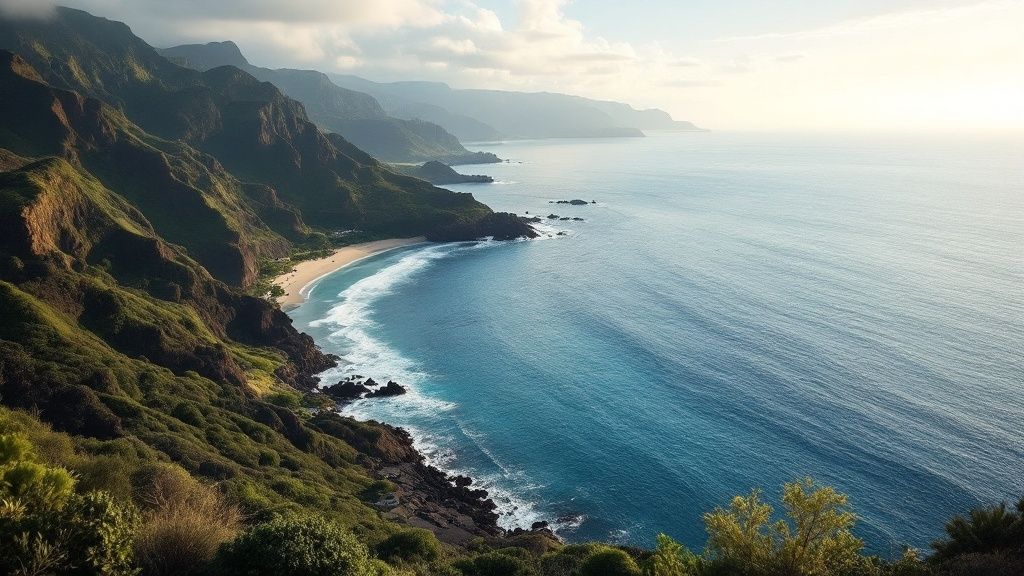Snorkel Kealakekua Bay: Epic Hawaii Adventure Worth Taking
- Kona Snorkel Trips
- Mar 26
- 11 min read
Why Snorkel Kealakekua Bay Should Top Your Bucket List
Kealakekua Bay isn't your average snorkeling spot. It's an underwater paradise that offers something truly special. Think 100+ foot visibility, a vibrant ecosystem teeming with marine life, and a rich history that adds another dimension to the experience. This unique combination makes Kealakekua Bay a must-see for any snorkeling enthusiast.
This exceptional visibility is a regular occurrence, not a rare event. The bay's sheltered location, protected from strong currents and winds, creates consistently calm and clear waters. Whether you're a seasoned pro or a beginner, you'll have an amazing view of the underwater world. Photographers regularly capture stunning underwater shots, showcasing the vibrant reef and its inhabitants.
Kealakekua Bay is also known for its incredible marine biodiversity. Designated a Marine Conservation District since 1969, this 315-acre bay supports a vast array of tropical fish and coral species. Learn more about Kealakekua Bay's conservation status here. This protected status helps ensure the ecosystem remains healthy for generations to come.
Why Kealakekua Bay Is Different
What truly sets Kealakekua Bay apart? Unlike many over-commercialized snorkeling spots, this bay retains its pristine natural beauty. Vibrant coral gardens teem with colorful fish, offering a glimpse into a thriving underwater ecosystem. Even beginners can have incredible experiences in these crystal-clear waters. You might be interested in: Our blog post sitemap for more information.
The bay's sheltered location and consistently pleasant water temperatures mean optimal snorkeling conditions year-round. You can plan your visit whenever it's most convenient, knowing you'll find perfect snorkeling conditions. Snorkeling in Kealakekua Bay isn't just looking at the ocean; it's a chance to connect with nature, history, and the magic of Hawaii.

The Fascinating History Beneath Kealakekua Bay's Waters
Snorkeling in Kealakekua Bay isn't just about vibrant coral and colorful fish. It's about immersing yourself in living history. This bay holds profound cultural and historical significance, making a snorkel trip a uniquely meaningful experience. Beyond the stunning underwater scenery, the stories woven into the bay transform a simple snorkel trip into a journey through time.
A Crossroads of Cultures
Kealakekua Bay served as a crucial point of contact between Native Hawaiians and Europeans. Most notably, it was the site of Captain James Cook's arrival in 1779. This encounter, and Cook's ultimate fate in the bay, forever shaped the course of Hawaiian history. The bay, located on the Big Island of Hawaii, is renowned for its snorkeling opportunities and its historical significance. Today, snorkeling in Kealakekua Bay offers an incredible underwater experience with crystal-clear waters and diverse marine life. The bay is protected as a State Marine Life Conservation District, ensuring its preservation. With over 190,000 visitors annually, snorkeling and kayaking are popular activities. Discover more insights about Kealakekua Bay’s history.
Landmarks That Whisper Stories
As you snorkel, you'll be swimming near significant landmarks. The Captain Cook Monument, a white obelisk on the shore, marks the location of his death. Nearby, the Hikiau Heiau, a traditional Hawaiian temple, provides a tangible connection to the past. These visible reminders of historical events give context to the underwater world, adding depth and meaning to your snorkeling experience.

More Than Just a Snorkel Trip
Today's knowledgeable tour guides enrich the experience by sharing cultural narratives. They share stories of ancient Hawaiian traditions, the events of Captain Cook's arrival, and the bay's continued spiritual significance to Native Hawaiians. This added layer of cultural understanding fosters a deeper appreciation for the underwater world. It's an opportunity to connect with the past while enjoying the present.
A Spiritual Connection
For many Native Hawaiians, Kealakekua Bay holds deep spiritual meaning. It's considered a sacred place, a connection to their ancestors and heritage. Understanding this spiritual dimension adds another layer of richness to your visit. It encourages a sense of respect and reverence for the bay and its history. Appreciating the cultural and historical aspects of Kealakekua Bay provides a deeper understanding of this special place. It’s a chance to connect with Hawaii on a profound level, making your snorkeling adventure unforgettable.
Insider Access: Best Ways to Snorkel Kealakekua Bay
Forget generic advice. Your ideal Kealakekua Bay snorkeling experience hinges on your personal priorities. Whether you crave a relaxing boat tour, an adventurous kayak trip, or a challenging hike, understanding the nuances of each access method is key.
Boat Tours: The Easy and Rewarding Option
For most visitors, boat tours represent the most convenient and enjoyable way to snorkel Kealakekua Bay. They offer a hassle-free experience, whisking you directly to prime snorkeling locations. This maximizes your time in the water without the physical demands of paddling or hiking. Many tours also include perks like snorkeling gear, snacks, and insightful commentary about the bay's history and marine life.
Boat tours cater to a spectrum of preferences and budgets, from large catamarans with water slides and diving platforms to smaller, more intimate vessels. For instance, Fair Wind Cruises offers a large-capacity tour with numerous amenities, while Dolphin Discoveries provides a smaller, more personalized experience. Sea Paradise occupies the middle ground, offering a mid-sized catamaran and two distinct snorkeling locations.
Kayaking: A More Active Adventure
Kayaking to Kealakekua Bay presents a more active and independent way to explore this captivating area. You'll savor breathtaking coastal views as you paddle across the bay. However, this option necessitates a reasonable level of fitness and prior paddling experience. You'll also need to secure a kayak permit and arrange transportation for your kayak to the launch point.
Despite the extra effort, kayaking affords greater flexibility. You can explore various sections of the bay at your own pace and potentially avoid the crowds often associated with boat tours. Remember to tether your kayak while snorkeling, as bringing it ashore near the Captain Cook Monument is prohibited.
Hiking: A Challenging but Rewarding Trek
The most demanding access method involves hiking the Captain Cook Monument Trail. This 1.8-mile trail descends 1,400 feet to the bay and is classified as moderate to strenuous. The hike typically takes 45-60 minutes going down and 1-1.5 hours returning uphill. While challenging, the hike rewards you with panoramic views and the chance to explore the Captain Cook Monument area up close. Keep in mind that you'll need to carry your own snorkeling gear, as rentals are unavailable at the monument.
Hiking offers a truly unique perspective of the bay and its surrounding landscape. It's a fantastic choice for seasoned hikers seeking a more immersive experience. However, adequate preparation for the physical demands of the hike is essential, including bringing plenty of water and sun protection.
To help you decide which method is best for you, take a look at the comparison table below:
Kealakekua Bay Access Methods Comparison A comparison of different ways to access Kealakekua Bay for snorkeling, including cost, difficulty, advantages and disadvantages
Access Method | Approximate Cost | Physical Difficulty | Permit Required | Key Advantages | Limitations |
|---|---|---|---|---|---|
Boat Tour | $100 - $200 | Easy | No | Convenient, access to best spots, amenities included | Less flexibility, potential crowds |
Kayaking | $50 - $100 (rental) | Moderate | Yes | Independent exploration, avoid crowds | Requires fitness and experience, kayak transport |
Hiking | Free | Strenuous | No | Unique perspective, immersive experience | Physically demanding, carry own gear |
As you can see, each method has its pros and cons. Boat tours are ideal for convenience, while kayaking offers more freedom, and hiking provides a challenging adventure.
Choosing the Right Access Method
Ultimately, the best way to snorkel Kealakekua Bay depends on your individual needs and preferences. Consider your fitness level, budget, and desired level of independence. For those prioritizing convenience and a comprehensive experience, boat tours are a great option. Kayaking offers a balance of activity and flexibility, while hiking provides a challenging but rewarding adventure. You might be interested in checking our guide for more information.

Extraordinary Marine Life When You Snorkel Kealakekua Bay
Forget vague promises of "colorful fish." Snorkeling Kealakekua Bay is an experience unlike any other, an immersion into a vibrant underwater world teeming with unique marine life. From dazzling schools of Yellow Tang to the intriguing behaviors of Butterflyfish, the bay offers unforgettable encounters.
Kealakekua Bay isn't just a pretty place; it's a thriving ecosystem. The diverse underwater landscape provides habitats for an incredible variety of species. Whether you're a seasoned snorkeler or a first-timer, the bay offers something for everyone.
Vibrant Reef Inhabitants
The reef system at Kealakekua Bay supports a remarkable diversity of species. Bright yellow Yellow Tang dominate the reef, their vibrant color a stark contrast against the deep blue water. These herbivorous fish play a crucial role in maintaining the reef's health by grazing on algae.
You'll also encounter Butterflyfish, known for their intricate patterns and curious nature. These active fish add to the vibrant tapestry of the reef. Keep a watchful eye out for Parrotfish, easily recognizable by their beak-like mouths used to scrape algae off the coral, contributing to the reef's overall health.
Exploring Different Reef Zones
Different species congregate in specific areas of the bay. Shallow, sunlit areas are ideal for observing colorful reef fish like Triggerfish and Moorish Idols. Deeper sections may reveal larger species like the occasional Green Sea Turtle or even a Whitetip Reef Shark.
The rocky outcrops near the Captain Cook Monument provide shelter for eels and octopus, adding an element of mystery to your underwater exploration. Exploring these diverse zones maximizes your chances of encountering a wide array of fascinating marine life.

To help you better understand the common inhabitants of the bay, take a look at the table below:
To help you plan your snorkeling adventure, we've compiled a guide to some of the most frequently encountered species:
Common Marine Species at Kealakekua Bay: A guide to the most frequently encountered marine species while snorkeling at Kealakekua Bay
Species Name | Appearance | Typical Locations | Best Viewing Times | Conservation Status |
|---|---|---|---|---|
Yellow Tang | Bright yellow, oval-shaped body | Shallow reefs, coral gardens | Daytime | Least Concern |
Butterflyfish (various) | Varied colors and patterns, distinct "eyespot" marking | Coral reefs, rocky areas | Daytime | Varies by species |
Parrotfish (various) | Large, beak-like mouth, often brightly colored | Coral reefs, rocky areas | Daytime | Varies by species |
Green Sea Turtle | Large, greenish-brown shell, flippers | Deeper waters, seagrass beds | Daytime | Endangered (some populations) |
Spinner Dolphin | Sleek, gray body, pointed snout | Open water, often near the bay entrance | Afternoon/evening | Least Concern |
Humpback Whale (seasonal) | Massive, dark-colored body, distinctive humped back | Open ocean, sometimes near the bay | Winter months | Least Concern |
This table provides a quick reference for some of the amazing creatures you might encounter. Remember that the ocean is a dynamic environment, and sightings are never guaranteed.
Time of Day Impacts Sightings
When you choose to snorkel can influence what you see. Morning snorkeling often offers calmer waters and better visibility, ideal for underwater photography. Consider using a GoPro for capturing stunning underwater footage. However, the afternoon can bring increased activity from certain species, especially when Spinner Dolphins visit the bay to rest and socialize.
Whenever you choose to go, remember to observe these magnificent creatures ethically, maintaining a respectful distance and avoiding any disruptive behavior. You might be interested in checking our page sitemap for more details.
Seasonal Variations
Marine life activity in Kealakekua Bay varies with the seasons. While the bay offers excellent snorkeling year-round, certain species are more prevalent during specific times. For example, Humpback Whales migrate to Hawaiian waters during the winter months, offering a chance for unforgettable encounters. Summer months bring warmer water temperatures, attracting a greater diversity of reef fish. Researching seasonal variations before your trip can help you plan for specific sightings.
Protecting Paradise: Snorkel Kealakekua Bay Responsibly
Snorkeling in Kealakekua Bay is a privilege. It offers a glimpse into a vibrant underwater world, teeming with life and color. But this delicate ecosystem faces threats, ironically, from its own popularity. It’s our responsibility to understand these challenges and adopt sustainable practices to protect this treasure for generations to come.
The Impact of Tourism
Kealakekua Bay draws a significant number of visitors each year. Over 190,000 people visit annually, contributing substantially to the local economy. This influx supports local businesses but also presents environmental concerns. Issues like improper waste disposal and disturbance of marine life need careful management. Find more detailed statistics here Balancing tourism with preservation is a key challenge, and individual responsibility plays a crucial role.
Sunscreen and Coral Health
One surprising threat to coral reefs is certain sunscreen ingredients. Chemicals like oxybenzone and octinoxate can damage coral, leading to bleaching and hindering growth. Choosing reef-safe sunscreens is essential for protecting both your skin and the coral. These eco-friendly alternatives minimize harm to this delicate ecosystem.
Respecting Marine Life
When snorkeling, it’s vital to respect the marine life. Maintaining a respectful distance is key. Touching or harassing marine creatures can disrupt their natural behaviors and cause undue stress. Avoid feeding fish, as this alters their feeding patterns and can negatively impact the reef's delicate balance. Observing these creatures passively allows us to appreciate their beauty without interfering with their lives.
Minimizing Physical Impact
Even small actions can have a significant impact on the reef. Simple steps like entering the water carefully, avoiding contact with coral, and refraining from anchoring on the reef structure are essential. Proper finning techniques, preventing accidental contact, are also crucial. Using designated entry and exit points minimizes disturbance to sensitive areas.
Supporting Responsible Tour Operators
Choosing responsible tour operators can make a real difference. Look for companies committed to sustainable practices. Captain Cook Snorkeling Tours, for instance, prioritizes education and conservation. They inform guests about proper reef etiquette and actively participate in conservation efforts. Supporting businesses like these reinforces responsible tourism.
Preserving Paradise for the Future
Protecting Kealakekua Bay is a shared responsibility. By making informed choices and adopting responsible snorkeling practices, we can ensure this underwater paradise thrives. Every action, from choosing reef-safe sunscreen to supporting conservation, contributes to preserving this natural wonder for future generations.
Cultural Respect While You Snorkel Kealakekua Bay
Snorkeling in Kealakekua Bay isn't just about exploring the underwater world; it's about immersing yourself in a place of deep cultural importance. Understanding the spiritual significance of the bay for Native Hawaiians can transform your snorkeling trip into something truly special.
Understanding Kealakekua Bay’s Significance
Kealakekua Bay holds a unique place in the hearts of Native Hawaiians. It's a point where the spiritual and natural worlds intertwine. Sites like Hikiau Heiau, the ancient temple on the bay's shore, are particularly sacred. Actions that might seem harmless to visitors, such as loud noises or climbing on the rocks near the heiau, can be deeply disrespectful. True cultural respect comes from understanding and honoring this spiritual dimension.
This area is not just historically significant, but also environmentally vital. Kealakekua Bay State Historical Park protects the natural and cultural heritage of the area. The park encompasses historic sites like the Captain Cook Monument and Hikiau Heiau, a traditional Hawaiian temple. Sustainable tourism practices are implemented to ensure the bay's historical significance isn't overshadowed by its popularity. The park's management strives to maintain a delicate balance between tourism and cultural preservation. Explore this topic further
Respectful Tourism Practices
Genuine respect involves more than just superficial actions. It's about actively minimizing your impact on both the environment and the local culture. Using reef-safe sunscreen helps protect the coral reefs. Supporting local businesses that uphold cultural traditions contributes to preserving Hawaiian heritage. This commitment to mindful tourism enriches your experience and safeguards this unique place.
Common Misunderstandings and How to Avoid Them
A common misconception is that all areas of the bay are open to visitors. Some areas are considered kapu, or forbidden, because of their spiritual importance. Respecting these boundaries is essential. Another frequent mistake is touching or disturbing artifacts or natural formations. These seemingly insignificant actions can be disrespectful and environmentally damaging. Learning about Hawaiian history and cultural practices before your visit will help you avoid these unintentional errors. You might be interested in: Our blog categories.
Meaningful Engagement with Hawaiian Culture
Engaging respectfully with Hawaiian culture enhances your snorkeling experience. Learning basic Hawaiian phrases, attending a cultural demonstration, or visiting a local museum can provide valuable insights. These efforts show a genuine interest in the local culture and create a deeper connection to the place. This mindful approach elevates your snorkeling trip from a simple recreational activity to a meaningful cultural experience.
The Importance of Cultural Preservation
Preserving Hawaiian culture is not just about protecting the past; it's about ensuring a thriving future. By practicing respectful tourism, we support the ongoing efforts of cultural practitioners, historians, and local communities to protect their heritage for generations to come. This awareness leads to more enriching experiences for visitors while preserving traditional values and customs. This shared responsibility ensures the enduring cultural and spiritual significance of Kealakekua Bay.
Experiencing the Bay with Respect
By embracing a mindful approach to snorkeling in Kealakekua Bay, you become more than a tourist. You become a steward of this extraordinary place, contributing to its protection and appreciating its beauty on a deeper level. This respect strengthens your connection to the bay and makes for a more enriching and rewarding snorkeling adventure.
Experience the magic of Kealakekua Bay with Captain Cook Snorkeling Tours. We prioritize cultural respect and environmental responsibility, making sure your adventure is both memorable and meaningful. Book your unforgettable snorkeling tour today!
